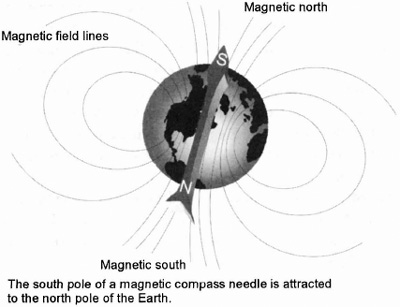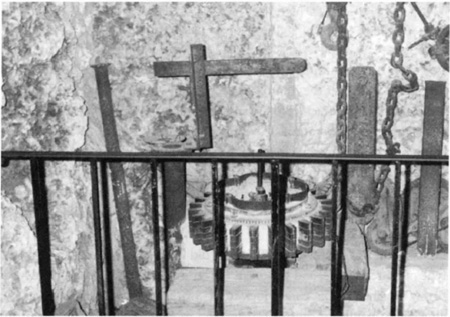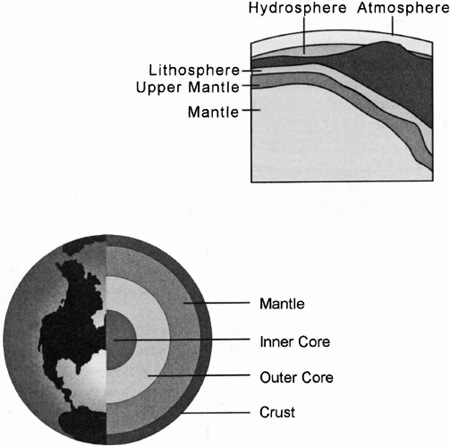The Giza Power Plant (18 page)

I realized that I had been laboring under the assumption that in order to create an antigravity device, gravity should be a known and fully understood phenomenon and that, through the application of technology, out-of-phase gravity waves would have to be created in such a manner as to neutralize it. As any physicist will tell you, the nature of gravity still eludes us, as does the ability to produce interference gravity waves.
So what if there is no such thing as gravity? What if the natural forces we already know about are sufficient to explain the noted phenomenon we have labeled as gravity? If, as Leedskalnin claimed, all matter consists of individual magnets, wouldn't the known properties of a magnet be sufficient? We know that like poles repel, and unlike poles attract. We also know that we can suspend one magnet above another as long as we do not allow either of them to flip over so that the opposite poles attract each other. Magnets seek to attract and, left to themselves, will align their opposite poles to each other. A mag-lev train is a good example of an antigravity device employing magnets.
The Earth, having the properties of a large magnet, generates streams of magnetic energy that follow lines of force. These lines of force have been noted for centuries (see Figure 26). If we assume, as Leedskalnin did, that all objects consist of individual magnets, we also can assume that an attraction exists between these objects due to the inherent nature of a magnet seeking to align its opposite pole to another. Perhaps Leedskalnin's means of working with the Earth's gravitational pull was nothing more complicated than devising a means by which the alignment of magnetic elements within his coral blocks was adjusted to face the streams of individual magnets he claimed are streaming from the Earth with a like repelling pole.

FIGURE 26.
Poles of Bar Magnet and Earth
A well-known method for creating magnetism in an iron bar is to align the bar with the Earth's magnetic field and strike the bar with a hammer. This blow vibrates the atoms in the bar and allows them to be influenced by the Earth's magnetic field. The result is that when the vibration stops, a significant number of the atoms have aligned themselves within this magnetic field.
Was this the method that Leedskalnin was using? It is a simple concept, and when I observed the devices in Leedskalnin's workshop, I could easily imagine the application of vibration and electromagnetism. His flywheel for creating electricity remains motionless, for the most part, until inquisitive tourists like me come along and give it a spin. After giving it a few revolutions, I realized that something was missing. The narrative I heard, while browsing around the castle, described Leedskalnin as using this device to create electricity to power his electric lightbulbs. It was claimed that Leedskalnin did not have electricity, but I could not imagine this device being a useful and continuing source of power, considering Leedskalnin used only his right arm to turn the wheel. On closer examination of the piece, I found that the whole assembly was actually an old four-cylinder
crankcase. His flywheel was mounted on the front end of the crankshaft and consisted of bar magnets that were sandwiched between two platesâthe upper plate being a ring gear. To give it weight and to solidify the entire assembly, Leedskalnin had encased the bar magnets with cement. It then occurred to me that the photo of Leedskalnin with his hand on the crank handleâwhich is attached to the end of the shaftâmay not accurately represent his entire operation. It is possible that Leedskalnin was using the crank handle to start a reciprocating engine, now missing, which attached to one of the throws on the crankshaft. He would then be able to walk away and leave his flywheel running.
I was now mystified. I had developed a notion that the bars attached to the flywheel were actually being used to develop vibration in the piece Leedskalnin was trying to lift. This idea did not make sense considering the type of material, size, and weight of the entire assembly. The crankcase was firmly attached to the coral block in his workshop, and even if it was not attached, it would be quite a feat to keep moving it about. There was one factor I needed to check out, though, before I headed back to Illinois. I had tested the bar magnet with a pocketknife. The knife was attracted to each bar. I needed to know, conclusively, the arrangement of the poles in the wheelâto see, indeed, whether the assembly was capable of creating electricity.
I headed for the nearest strip mall to look for a hardware store so that I could buy a bar magnet. The first one had just what I neededâand for only $1.75. Feeling rather pleased, I returned to Coral Castle.
Once there, I headed back into Leedskalnin's workshop and put the magnet to the test. I held it a short distance away from the spokes of the flywheel while giving it a spin. Sure enough, I found out what I had come for. The magnet pushed and pulled in my grasp as the wheel rotated. Looking around the space, I gazed at a jumble of various devices, lying, hanging, and leaning about the room (see Figure 27). There were radio tuners, bottles with copper wire wrapped around them, spools of copper wire, and other various and sundry plastic and metal pieces that looked as if they had fallen out of an old radio set. Leedskalnin's workshop also contained chains, block and tackle, and other items that one might find lying around a junkyard. Some items were missing, though. Photographs of Leedskalnin at work show three tripodsâmade of telephone polesâthat have boxes attached to the
top. These objects, however, are not to be found at Coral Castle. What is striking in the photograph is that the block of coral being moved is seen off to the side of the tripod. Perhaps Leedskalnin had moved the tripod after raising the block out of the bedrock. Another interesting observation is that the block and tackle that can be found inside his workshop is nowhere to be seen in this photograph. There are spools of copper wire in his workshop, and two wrappings of copper wire hang from nails in the wall. One was round copper and the other flat copper. In a narrative that visitors can hear at various recording stations around the compound, it is stated that at one time Leedskalnin had a grid of copper wire suspended in the air. Looking at the photograph again, one can see that there is a cable draped around the tripod and running down to the ground. Perhaps the arrangement of tripods was more related to the suspension of his copper grid than to the suspension of block and tackle.

F
IGURE
27.
Ed Leedskalnin's Workshop
If I were to try to replicate Leedskalnin's feat, I would begin with the premise that he was using his flywheel to generate a single-frequency tunable radio signal. The box at the top of the tripod would contain the radio
receiver (there are several tuners in Leedskalnin's workshop), and the cable coming from the box would be attached to a speaker that emitted sound to vibrate the coral rock at its resonant frequency. With the atoms in the coral vibrating (like those in an iron bar), I would then attempt to flip their magnetic polesâwhich are naturally in an attraction orientation with the Earthâusing an electromagnetic field.
Although today we stand in amazement before ancient megalithic sites that were built employing huge stones, if we had Leedskalnin's technique for lifting huge stones, it would make sense to us that the ancient masons might make their building blocks as large as possible. Very simply, it would be more economical to build in that manner. If we had a need to fill a five-foot cube, the energy and time required to cut smaller blocks would be much greater than what would be required to cut a large one.
I have no doubt that Leedskalnin told the truth when he said he knew the secrets of the ancient Egyptians. Unlike those who have sought publicity for their own inadequate, although politically correct, theories, he proved his theory through his actions. I believe, also, that we can rediscover his techniques and put them to use for the benefit of humankind. Edward Leedskalnin, right or wrong, had a little bit of a problem with trustâbut this modus operandi was not unusual for a craftsperson of his day. Proprietary techniques without patent disclosure assure continued employment; therefore, it was perfectly normal that he would protect his secret from prying eyes that might steal and profit from it. I believe there are enough pieces of the puzzle in Leedskalnin's workshop to allow us to put them together and replicate his technique. It has been done once (sorry, twice!), and I am sure that it can be done
again.
1
Chapter Seven
ENDEAVORING TO EXPLAIN THE ENIGMA

A
s we have seen, the evidence carved into the granite artifacts in Egypt
clearly points to manufacturing methods that involved the use of machinery such as lathes, milling machines, ultrasonic drilling machines, and high-speed saws. They also possess attributes that cannot be produced without a system of measurement that is equal to the system of measure we use today. Their accuracy was not produced by chance, but is repeated over and over again.
After I assimilated the data regarding the ancient Egyptians' manufacturing precision and their possible andâin some instancesâprobable methods of machining, I suspected that to account for the level of technology that the pyramid builders seem to have achieved, they must have had an equally sophisticated energy system to support it. One of the pressing questions we raise when we discuss ancient ultrasonic drilling of granite is, "What did they use as a source of power?" A still more forceful inquiry regarding the use of electricity necessary to power ultrasonic drills or heavy machining equipment that may have been used to cut granite is, "Where are their power plants?" Obviously there are no structures from the ancient world that we can point to and identify as fission reactors, or turbine halls. And why should we have to? Isn't it a bit misguided of us to form an assumption that the ancient power plants were even remotely similar to ours?
Nevertheless, there may be some fundamental similarities between ancient and modern power supplies, in that the power plants in existence today are quite large and all need a supply of water for cooling and steam production. If such an advanced society existed in prehistory and if indeed they had an energy system, we could logically surmise that their power plants in all probability would be the largest construction projects they would
attempt. It also may follow that, as the largest creations of the society, those power plants would stand a good chance of surviving a catastrophe and the erosion of the elements during the centuries that followed.
The pyramids easily meet these requirements. These geometric relics of the past, which have been studied, speculated about, and around which so much debate has centered, are located near a water supply, the Nile River, and, indeed, are the largest building projects that this ancient society completed. In light of all the evidence that suggests the existence of a highly advanced society utilizing electricity in prehistory, I began to seriously consider the possibility that
the pyramids were the power plants of the ancient Egyptians.
Like just about every other student of the Egyptian pyramids, my attention was focused on the Great Pyramid, primarily because this is the one on which everybody else's attention had been focused, resulting in more research data being available for study. The reports of each successive researcher's discoveries inside the Great Pyramid are quite detailed, especially Petrie's. It is as though researchers became obsessed with reporting data, regardless of how insignificant it may have seemed.
Researchers have especially noted the Great Pyramid's geometric dimensions. Having worked with dimensions and angles all my working lifeânot just for the sake of dimensions themselvesâtheir relevance in the Great Pyramid, while being important, was not of a primary concern to me. The dimensions, after all, are not the object, but a means to create the object. The area of study that I felt would reveal the true purpose of the Great Pyramid was a thorough examination of the inner chambers, passages, and every little detail that has been noted within them. While I was studying the inner chambers and passages of the Great Pyramid, I became convinced that I was looking at the prints for an extremely large machine, except this machine had been relieved of its inner components for some inexplicable reason. It is difficult to envision a machine that big, but with this basic premise I studied the drawings a little closer in order to obtain an understanding of how it might have operated.
The tremendous amount of masonry used in constructing this edifice suggested to me that there were things happening inside this pyramid that made such quantity necessary. Also, it seemed that the only logical reason an advanced civilization would have to build such a structure, at an obviously
vast expenditure of time and energy, would be the same and only reason our civilization would need to duplicate itâto provide the population with some return on their investment. Energy would be such a return.
At the time the early explorers were crawling through the Great Pyramid, science and technology were at such a point that the basic foundations for explaining its true purpose had not yet been laid. At that time in our technological history, it would have been impossible for those researchers to entertain the thoughts recorded in this book; therefore, it is true to say that the science embodied in the Great Pyramid was lost to early explorers. But is this ancient science still lost?
I believe that the scientific foundation has been laid to attain that elusive lost science. In proposing my theory that the Great Pyramid is a power plant, I am not adamantly adhering to anyone proposition. The possibilities may be numerous. However, the main facts are inescapable, for they were noted many years ago, and it would be impossible for an open-minded, logically thinking person to disregard them.
As we head toward the new millennium, the interest in ancient civilizations and the pyramids is gaining momentum. The idea that the Great Pyramid of Giza was built for the generation or as a source of energy is not new. Other authors have alluded to this idea and have made valuable contributions in the research of the Great Pyramid.
It is an exciting time we are living in. New information coming from Giza indicates that the theory that follows will find more evidence and proof to support it. Rudolph Gantenbrink's exploration in 1993 provided some of that proof, as I will shortly discuss. And testing in the Great Pyramid's King's Chamber by Tom Danley of the Schor expeditionâthough currently shrouded in secrecy imposed by a nondisclosure agreementâpromises to reveal a tremendous amount of new and relevant information. Through the efforts of these researchers, and the groundwork laid by generations of others' enlightenment is about to dawn in the hazy world of Egyptology and we can be confident that the real truth about our distant ancestors in prehistory will soon come to light. The theory that follows, and the evidence I have gathered to support it, will, I hope, bring us one step further into the light of awareness about our speciesâwhere we were, where we are, and where we may be heading.

FIGURE 28.
The Earth's Layers